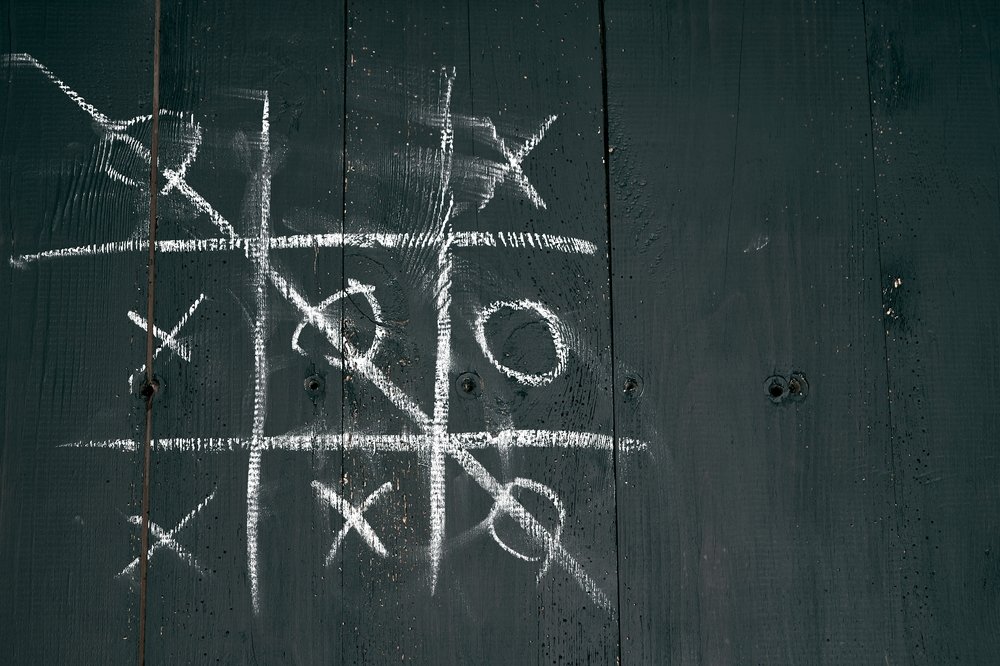Last Updated on January 25, 2024 by Gamesver Team and JC Franco

Tic-Tac-Toe is a game that has been enjoyed by millions of people for hundreds of years. It is a very basic game, yet the enjoyment factor reaped from it may be the reason for its popularity over so many generations. Many myths surround Tic-Tac-Toe, many of which are quite interesting.
Below, we will explore some of the most intriguing myths surrounding the game and discuss them in detail.
As you’ll see, there are many exciting myths about Tic-Tac-Toe ready to be discussed and debunked. If you’re ready to gather some interesting information and learn the truth about the game, read on.
Tic-Tac-Toe: 11 myths and misconceptions
1. Tic-Tac-Toe is a game that originated in the USA.
Tic-Tac-Toe, interestingly enough, originated from the ancient Roman Empire. Many people wrongly believe that it’s an American game. These origins were discovered through diggings at several excavation sites where the ancient Romans lived.
It seems that back then, players would have used different tools to what we do today. Both players would receive three pebbles each, which would somewhat act as their Xs or Os. As you can imagine, the gameplay must have been vaguely different from what it is today.
2. Tic-Tac-Toe has always been a game played by children.
In today’s times, it seems like most Tic-Tac-Toes players are children as it is a game that has basic concepts to learn and requires as little as a pencil and paper to play.
Through studies of ancient societies such as ancient Egypt, it is clear that citizens of the highest status and even pharaohs would play three-in-a-row games as a source of enjoyment and socializing.
If you look a few centuries down the line, it was believed that early versions of the game had the ability to reveal certain secrets of the world. This came from the belief that the numbers 1-9 could have messages behind them and enable people to understand the world on a deeper level.
Also, pagan rituals have been found to have included setups like Tic-Tac-Toe as a numerological tool to cast spells. This evidence shows that in the past generations, this game was a whole lot more than just a children’s game.
3. The game has a total of 138 possible moves between the two players.
Tic-Tac-Toe is a game that is played on a board that consists of a 3×3 grid, meaning that the player starting off the game only has nine possible moves. The second player would have an option of eight moves, and so it goes on.
Interestingly enough, if you were to calculate the number of possible moves both players could make in a game of Tic-Tac-Toe, there would be an astounding 362,800 moves.
With that in mind, without considering symmetrical combinations, there are just 138 ways a person can win.
4. The name Tic-Tac-Toe is the only correct name for the game.
The earliest known version of the game went by the name “Terni Lappili”, which the Ancient Roman People coined.
If you were to look to relatively more recent times, you would find that in the 19th century, the name “Naughts and Crosses” came about. This name was created in Britain and has become somewhat of a more common name used in modern times.
The USA adopted Naughts and Crosses in the 20th century, but they renamed it Tic-Tac-Toe. Ever since then, it seems to be the name that has stuck in many westernized countries.
5. There are no variations in the rules of Tic-Tac-Toe.
The rules of Tic-Tac-Toe are straightforward; however, over the years, there have been variations of the game. The current version utilizes a grid of 3×3, and the idea of the game is to place three either ‘0’ or ‘X’ in a row.
The Romans had a different version that saw each player only having three pebbles to move around, which meant that they would keep on picking up the pebbles to make the next move making the game more challenging.

A more modern version called Three-dimensional Tic-Tac-Toe uses three boards of 3×3 grids, and the first one to get three in a row on any of the boards, or a combination of the board wins.
6. Tic-Tac-Toe is the most played game of all time.
This is one of the more difficult myths to debunk, as finding a one hundred percent certain decision would require research going thousands of years back.
Although Tic-Tac-Toe (and different versions) have been played for thousands of years, it seems that games such as checkers, chess, and backgammon have been played over more extended periods, as well as being more popular games in today’s times.
7. Tic-Tac-Toe is only prevalent in westernized countries.
This myth is a bit easier to debunk. It is a commonly known fact that globally Tic-Tac-Toe is one of the first games children are taught in schools worldwide. It is easy to understand and easy to play as all you require is a pencil and paper.
If you were to draw a board in front of a person just about anywhere in the world and started playing, it is very likely that the person in front of you would know how to play Tic-Tac-Toe. It is pretty impressive how a simple game could have such a broad reach globally.
8. The history of the game is uncertain.
The history of the game is accurately traced back throughout history. This is due to historians and archeologists finding boards and markings found in Ancient Rome. It’s believed that three-in-a-row games have also been played in Ancient Egypt.
If we look a couple of thousand years down the road, we see the game showing up in England and becoming increasingly popular. A few hundred years after that, it reaches the USA, and the rest is history.
9. Tic-Tac-Toe was a game created purely for enjoyment.
Over the years, it seems that Tic-Tac-Toe has been a game that is purely played for enjoyment; however, if you do some research, you will find that there are competitive games too, where players can earn money prizes!
Actually, there is a Tic-Tac-Toe World Championship where the best players come together to find out who the best player is.
10. It was a game mainly played by poorer uneducated people in its early days.

This is a myth that can be debunked through years of evidence. In its earliest days, the majority of markings and boards found were found in temples, places of worship, and even in palaces. These were all places of higher status people suggesting that it was a game that was probably played by all types of citizens during these times.
11. There is a sure way to win at Tic-Tac-Toe.
There are many ways to win Tic-Tac-Toe. Throughout the years of its existence, it is no surprise that people have been studying the game, trying to decipher what the best strategy is to win.
Although there is no one way to win every time, due to the different optional moves your opponent has at their disposal, what has been discovered is that the player that goes first has a massive advantage.
Conclusion
Tic-Tac-Toe is an entertaining game that has an exciting history. The myths that have been debunked above are questions and thoughts that have accumulated over many years.
Tic-Tac-Toe is a game that has been around for centuries, and there is no doubt that it will exist for many more to come.
Next time you decide to have a game of Tic-Tac-Toe, spare a thought for our Ancient Roman predecessors who were, for all intents and purposes, the reason why we got to know the game!

